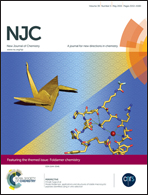New efficient fused-ring spiro[benzoanthracene-fluorene] dopant materials for blue fluorescent organic light-emitting diodes†
Abstract
New blue fluorescent spirobenzoanthracene-type dopant materials, 3,9-di(di(p-tolyl))aminospiro[benzo[de]anthracene-7,9′-fluorene] (DTSBAF) and 3,9-di(di(4-biphenyl))aminospiro[benzo[de]anthracene-7,9′-fluorene] (DBSBAF), were designed and successfully prepared by an amination reaction of 3-bromo-9-chlorospiro[benzo[de] anthracene-7,9′-fluorene] with di(p-tolyl)amine and di(4-biphenyl)amine, respectively. The EL characteristics of 1,10-dinaphthylspiro[benzo[ij]tetraphene-7,9′-fluorene] (DNSBTF) as the blue host material doped with the above blue dopant materials was evaluated. The electroluminescence spectra of indium tin oxide (150 nm)/N,N′-diphenyl-N,N′-bis[4-(phenyl-m-tolyl-amino)phenyl]-biphenyl-4,4′-diamine (DNTPD, 60 nm)/N,N,N′,N′-tetra(1-biphenyl)-biphenyl-4,4′-diamine (TBB, 30 nm)/SBTF hosts: SBAF dopant (20 nm, 5%)/9,10-di(naphthalene-2-yl)anthracen-2-yl-(4,1-phenylene)(1-phenyl-1H-benzo[d]imidazole) (LG201, 20 nm)/LiF (1 nm)/Al (200 nm) with DNSBTF as a host material show a blue emission band with a full width at half maximum of 50 nm and λmax = 472 nm. The device obtained from DNSBTF doped with DTSBAF showed a good color purity (0.141, 0.254), high luminance efficiency (10.12 cd A−1 at 5 V) and high external quantum efficiency (6.02%).
![Graphical abstract: New efficient fused-ring spiro[benzoanthracene-fluorene] dopant materials for blue fluorescent organic light-emitting diodes](/en/Image/Get?imageInfo.ImageType=GA&imageInfo.ImageIdentifier.ManuscriptID=C5NJ00143A&imageInfo.ImageIdentifier.Year=2015)

 Please wait while we load your content...
Please wait while we load your content...